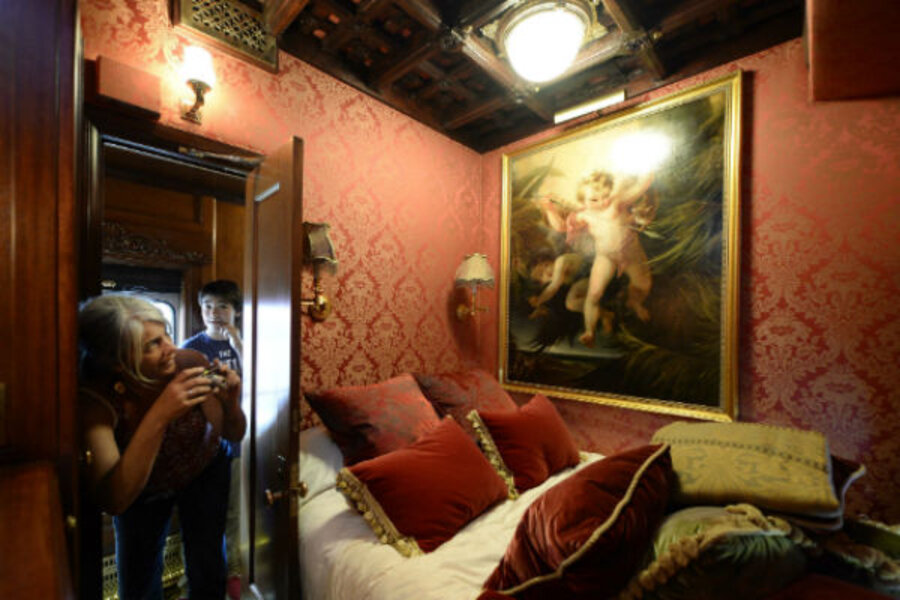National Train Day: Why slow travel may be better for families
Loading...
Sunset Limited. Hiawatha. Empire Builder. Super Chief. I can’t hear the names of the great American train lines without finding myself completely smitten. The Romance of the Rails has gotten to me pretty much every time I’ve taken a train, even a lowly commuter one.
Annually, May 10 is National Train Day, and hundreds of cities and towns across the US are celebrating with events, entertainment, and exhibits at train stations and other locations.
My first long-distance trip was on the Coast Starlight, a two-night journey (was it supposed to be one? I didn’t care) from San Francisco to Seattle. I highly recommend this, and other long-distance routes, for family travel.
My 7-year-old daughter and I boarded the train about midnight, when many of the passengers were already asleep. We were given warm chocolate chip cookies as we tiptoed to our sleeping car. We both stayed up most of the night, staring out the train window at the houses and yards as they passed by in slices, under a full moon, at just the right speed for contemplation. The train’s mournful whistle occasionally sounded onto the empty main streets. At rural stops, a passenger or two would come aboard, their drivers shuffling back to their hulking cars.
In the morning, we ate on a table set with a white tablecloth, as the train circled a snow-covered Mt. Shasta in northern California. We’d later play games in the observation car, meet Europeans who talked politics, and American father-son pairs touring the country’s ball parks, watch movies in a beautiful, lower-level movie screening car, and continue staring out the window at the tiny logging towns, the green college towns, the gorge-filled Willamette Valley in Oregon, and the fir-lined Cascade Mountains in Washington. We may have been a full day late getting into Seattle but, of course, we couldn’t have been happier.
A few summers ago, I had the pleasure of taking Amtrak's Washington D.C. to New York City train (which bore the unromantic name, Acela) and, truly, just a window seat and a garden burger were enough to make my day. Dusk and sunset didn’t hurt the mood, either, as I took in every aluminum-sided diner (themselves former train cars), corner tavern, brick row house, backyard swing set, hilly main street, church steeple, and pane-windowed factory building as the train swung through Delaware, Pennsylvania, and New Jersey, and finally to its resting place in a tunnel beneath Penn Station. Only the vaulted Grand Central lobby would have made the trip more complete. I could have come with this placard of warning - "Beware: Romantic, yearning West Coast person experiencing train rapture."
Our car attendant on that first trip from California and Washington was named Douglas and he seems to be a character of lore among Coast Starlight riders. From the first bite of cookie on, we knew we were in good hands. A big man, I’ll never forget him cruising through the dining car, about mid-morning, calling out “Hungry Man Walking.” His humor (and our laughter) continued the whole trip.
We slept in a “roomette”, really a closet with beds that hinged out from the walls. (We since booked a family sleeping car, for a second trip on the Coast Starlight. It is roomy and sleeps four, but sacrifices views.) What we didn’t have, apparently, was the grand-era Pullman sleeper car service and room.
While George Pullman didn’t invent the sleeper car, it was he who realized there was a market in luxury, comfort, and service, and he and his Pullman cars dominated the industry during its golden age, when everyone traveled by train.
A key component of Pullman service was the Pullman porter. The porters were African American men — the first porters were former slaves — and it is said that, even though some of the work could be demeaning, Pullman provided them with almost unequaled earning opportunity and job security for the times. During World War II, there were 12,000 Pullman porters. Their union was referred to as a Brotherhood. The last Pullman car made its run on December 31, 1968, a victim of faster modes of transportation such as the airplane and the car.
Supreme Court justice Thurgood Marshall, former San Francisco mayor Willie Brown, and Olympic athlete Wilma Rudolph are just three famous offspring of Pullman porters.
National Train Day was started by Amtrak in 2008 and commemorates the “golden spike” that was driven into the final tie that joined the Central Pacific and the Union Pacific railways, thus creating America’s first transcontinental railroad, on May 10, 1869. It's a perfect opportunity to salute Pullman porters, and the grand era of rail travel, even if it comes today in the form of a refurbished Parlor Car and not regular train travel.
Visit the National Train Day web site for complete event information and other resources about train history.
I suggest this site to get lost in some wonderful train horn sounds.
The Christian Science Monitor has assembled a diverse group of the best family and parenting bloggers out there. Our contributing and guest bloggers are not employed or directed by the Monitor, and the views expressed are the bloggers' own, as is responsibility for the content of their blogs. Susan Sachs Lipman blogs at Slow Family Online.








